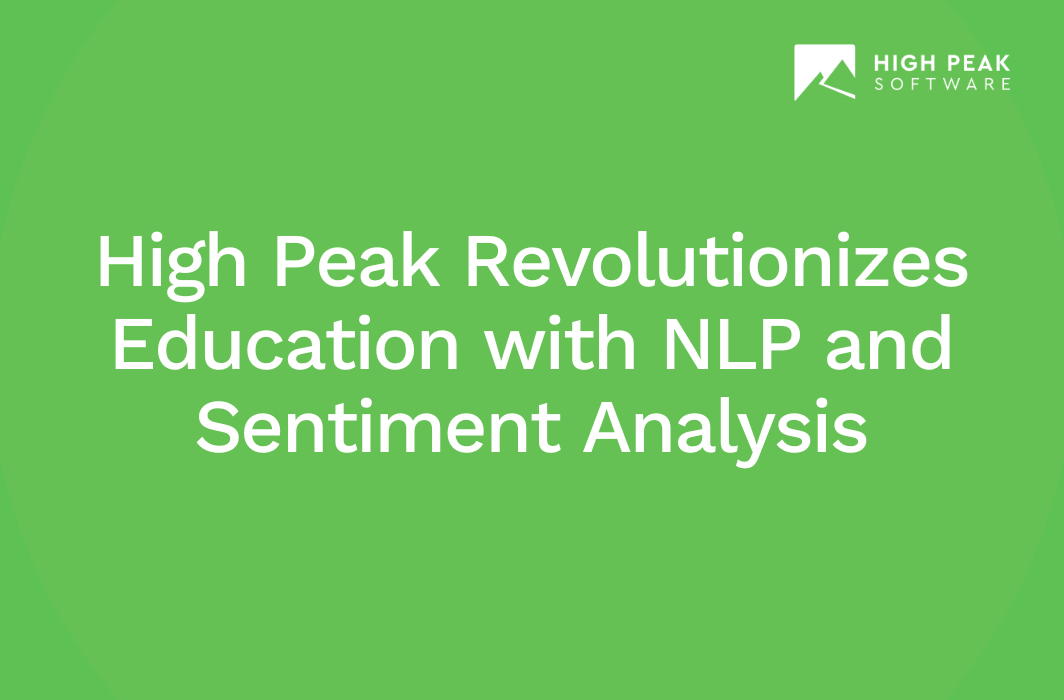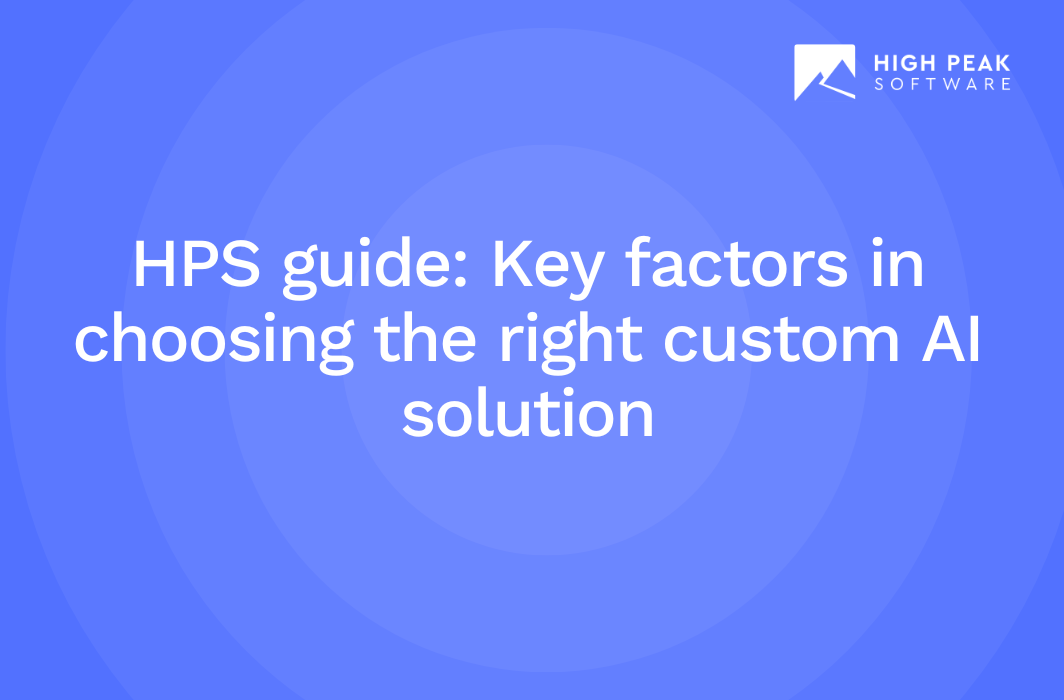High Peak Revolutionizes Education with NLP and Sentiment Analysis
Ayaan Bhattacharjee
Content Writer

Table of Contents
- How NLP and sentiment analysis can enhance classroom engagement
- What is classroom engagement?
- NLP and its application in education
- Leveraging NLP and sentiment analysis for enhanced engagement
- Top 5 benefits of using NLP and sentiment analysis in education
- Future trends and possibilities
- What did High Peak Software develop to stay ahead of the competition?
- Let High Peak help you revolutionize education with NLP and sentiment analysis
In today’s rapidly evolving technological landscape, Natural Language Processing (NLP) is poised to reshape education fundamentally. NLP, a branch of artificial intelligence (AI), focuses on human-language interaction, enabling machines to understand, interpret, and generate human-like text.
The global Natural Language Processing (NLP) market size was valued at USD 19.68 billion in 2022 and is projected to grow from USD 24.10 billion in 2023 to USD 112.28 billion by 2030. Thus exhibiting a CAGR of 24.6% during the forecast period. Within the educational sphere, NLP holds the potential to address a perennial challenge: classroom engagement.
This blog delves into the multifaceted aspects of NLP and sentiment analysis in education. It explores how NLP can adapt educational content to individual learning patterns and preferences while sentiment analysis offers insights into students’ emotional well-being, enabling tailored teaching approaches.
How NLP and sentiment analysis can enhance classroom engagement
Classroom engagement is the linchpin of effective education, driving knowledge retention, critical thinking, and overall academic success. However, maintaining high engagement levels is a persistent challenge for educators, particularly with diverse student populations and learning preferences.
This exploration centers on the dynamic interplay between NLP and sentiment analysis and their role in enhancing classroom engagement. NLP equips educational institutions with tools to harness the power of language, while sentiment analysis adds an emotional dimension by discerning students’ sentiments and attitudes during learning.
What is classroom engagement?
Classroom engagement is a multifaceted concept in the educational context, encompassing the active participation, interest, and involvement of students in the learning process. It goes beyond mere attendance; it reflects a student’s emotional, cognitive, and behavioral investment in their education. Engaged students are enthusiastic, motivated, and responsive, contributing positively to the overall classroom environment.
The crucial role of classroom engagement
Classroom engagement is not just a desirable trait; it is a fundamental pillar of effective learning. When students are engaged, they are more likely to absorb and retain information, think critically, and apply knowledge beyond the classroom. It fosters a dynamic and interactive learning environment where students are not passive recipients of information but active participants in their education.
The alarming challenge of low engagement
Research findings and statistics underscore the alarming challenge of low engagement in traditional classrooms. Student engagement is pivotal for academic success, yet low classroom engagement poses significant challenges for both students and teachers. Several factors contribute to low engagement, including repetitive content, learning disabilities, classroom management, challenging environments (especially in high-poverty schools), and mental health challenges.
Identifying disengagement isn’t always straightforward, but addressing it is crucial. To enhance engagement, teachers can employ strategies like active learning, student-centered instruction, and positive reinforcement. Involving parents and the community in the learning process can also foster better engagement, ultimately improving students’ academic performance and well-being.
NLP and its application in education
NLP systems process vast amounts of text data, employing algorithms to identify patterns, extract information, and respond intelligently. By bridging the gap between human communication and machine understanding, NLP opens doors to a multitude of applications, including language translation, chatbots, and sentiment analysis, transforming the way we interact with technology.
NLP’s potential in education
NLP’s versatility extends to the education sector, promising innovative solutions to age-old challenges. It can analyze students’ language patterns to identify individual learning styles, facilitating personalized content delivery. NLP-driven chatbots offer real-time assistance, enhancing student support.
Moreover, NLP can streamline the grading process, providing prompt and consistent feedback. In essence, NLP enhances the classroom experience by tailoring instruction, improving accessibility, and optimizing administrative tasks, ultimately fostering a more engaging and efficient learning environment.
Sentiment analysis in education
Sentiment analysis, a powerful tool in Natural Language Processing (NLP), enables the evaluation of emotions and attitudes expressed in text. In the educational context, it offers educators invaluable insights into the emotional well-being of students, paving the way for more empathetic and tailored teaching methods.
Sentiment analysis, also known as opinion mining, is a branch of NLP that involves identifying and interpreting sentiments and opinions expressed in text data. It holds great significance in education as it helps gauge student emotions, attitudes, and satisfaction levels. By analyzing student feedback, comments, or essays, educators can better understand how students perceive their learning experiences, enabling them to make informed adjustments to improve engagement and overall well-being.
Applying sentiment analysis in educational Settings
Sentiment analysis tools are increasingly utilized in educational settings to extract meaningful insights from student-generated content. For instance, analyzing discussion forum posts can reveal students’ sentiments toward course materials.
Social media posts can provide real-time feedback on on-campus events or academic issues. Sentiment analysis can also help detect signs of stress or frustration in student essays, allowing educators to offer timely support. Such applications empower educational institutions to proactively address concerns, creating a more responsive and student-centric environment.
Also read: Moving beyond boolean search: Explore High Peak’s AI development expertise
Leveraging NLP and sentiment analysis for enhanced engagement
This section delves into the combined potential of Natural Language Processing (NLP) and sentiment analysis to transform classroom engagement. We explore how they capture and assess student interactions and emotions, leading to more captivating and effective learning environments.
NLP’s role in evaluating student interactions
NLP plays a pivotal role in capturing and assessing student interactions, both spoken and written. It can analyze classroom dialogues, online forums, and written assignments, identifying patterns in student engagement levels. Understanding how students interact with course materials and peers allows educators to refine their teaching strategies, promote active participation, and adapt content to individual learning styles.
Sentiment analysis serves as a crucial tool for gaining insights into the emotional aspects of the learning process. By examining sentiments expressed in student feedback, comments, or written assignments, educators can gauge emotional states during lessons. Detecting signs of frustration or engagement enables timely interventions, enhancing student well-being and overall involvement. This dual approach of NLP and sentiment analysis empowers institutions to establish adaptive and emotionally responsive learning environments.
Top 5 benefits of using NLP and sentiment analysis in education
Delving into the top five benefits of incorporating NLP and sentiment analysis in education, this section uncovers how these technologies revolutionize the learning landscape. From personalized instruction to improved student outcomes, we explore the transformative potential these tools offer in enhancing the educational experience.
Personalized learning
NLP and sentiment analysis empower educators to offer personalized learning experiences. By analyzing student language patterns and emotional states, teachers can adapt their teaching methods to cater to individual needs. This customization fosters greater student engagement, as learners feel that their unique preferences and requirements are acknowledged. Consequently, students are more likely to grasp and retain knowledge, resulting in improved academic performance.
Efficient feedback mechanisms
NLP and sentiment analysis automate grading and assessment processes. This automation ensures that students receive timely and consistent feedback on their work. Educators can focus more on providing meaningful insights rather than administrative tasks. Prompt feedback allows students to track their progress and make necessary improvements, creating a more supportive and efficient learning environment.
Improved student retention
Through personalized support and enhanced engagement, NLP and sentiment analysis contribute to higher student retention rates. Students who feel their unique needs are met are more likely to remain committed to their educational journey. This sense of belonging enhances their overall satisfaction with the institution and encourages them to continue their studies.
Enhanced academic performance
The tailored teaching methods and emotional insights derived from NLP and sentiment analysis lead to improved academic outcomes. When students receive instruction that aligns with their learning styles and emotional well-being, they are better equipped to excel academically. Higher levels of engagement, personalized support, and efficient feedback mechanisms all contribute to enhanced academic performance.
Empowering educators
NLP and sentiment analysis automate time-consuming administrative tasks, allowing educators to focus more on teaching and student support. By reducing the burden of manual grading and assessment, these technologies give teachers more time to invest in creating enriching learning experiences. Educators can also use the insights generated by NLP and sentiment analysis to fine-tune their teaching methods and provide targeted support to students, ultimately making them more effective in their roles.
Future trends and possibilities
Natural Language Processing (NLP) and sentiment analysis are rapidly evolving fields with many emerging trends and possibilities. Here are some insights into the future of NLP and sentiment analysis in education:
Context-aware and personalized language processing: One significant trend to be observed in the future of NLP is a move towards more context-aware and personalized language processing. This means that NLP models will be able to understand the context of a conversation or text and provide more relevant and personalized responses.
Virtual assistants: Virtual assistants are becoming more popular in various industries, including education. They improve customer relationships and worker productivity through smarter assistance functions.
Multilingual language models: Multilingual language models are another emerging trend in NLP. They enable language processors to understand and generate text in multiple languages.
Named entity recognition: Named entity recognition is a technique used in NLP to identify and classify named entities in text. It is becoming more popular in education for tasks such as identifying key concepts in educational materials.
Reinforcement learning: Reinforcement learning is a type of machine learning that enables NLP models to learn from their mistakes and improve over time. It is becoming more popular in NLP and could be used to improve educational chatbots and virtual assistants.
What did High Peak Software develop to stay ahead of the competition?
In the ever-evolving landscape of enterprise solutions, staying ahead of the curve is paramount. High Peak Software achieves just that with Scrievance, an advanced knowledge-processing software that uses AI-powered NLP and Sentiment Analysis to reshape the way businesses understand and utilize document-fed information.
Optimal process optimization
Scrievance isn’t your run-of-the-mill software; it’s a game-changer. It leverages cutting-edge technologies and innovative learning methodologies to optimize processes within enterprises. It’s not just about managing documents; it’s about transforming them into valuable insights.
Efficient thought capture
With the integration of narrative intelligence and natural language processing (NLP), Scrievance takes information understanding to the next level. It captures thoughts efficiently, translating unstructured content into structured knowledge. This means your organization can extract meaningful insights from vast amounts of data in real time.
Enhanced document management
Gone are the days of sifting through piles of documents. Scrievance simplifies document management, making it a breeze. It empowers users to create comprehensive and successful reports effortlessly right from the outset. Say goodbye to tedious, time-consuming tasks and embrace efficient, streamlined workflows.
Dynamic process platform
Scrievance isn’t just software; it’s a dynamic process platform. It doesn’t just convert information into knowledge; it equips your organization with unparalleled insights. Our specialization lies in effectively harnessing unstructured content, ensuring that every critical detail is preserved.
In short, High Peak-built Scrievance represents a monumental leap forward in knowledge management with profound implications for education. By harnessing the power of NLP and sentiment analysis, this software not only transforms data into actionable insights but also enhances the educational experience. It’s not just about staying ahead; it’s about nurturing a more informed and emotionally engaging approach to learning, setting the stage for a brighter future in education.
Let High Peak help you revolutionize education with NLP and sentiment analysis
In conclusion, the integration of NLP and sentiment analysis in education represents a promising path toward more engaging and effective classrooms. These technologies offer personalized learning, streamlined feedback, and increased student involvement. To embark on this transformative journey, reach out to High Peak for NLP and sentiment analysis applications tailored to your educational needs.
Ready to revolutionize education?
Click Here to book a call with High Peak for all your NLP and Sentiment Analysis Solutions!




